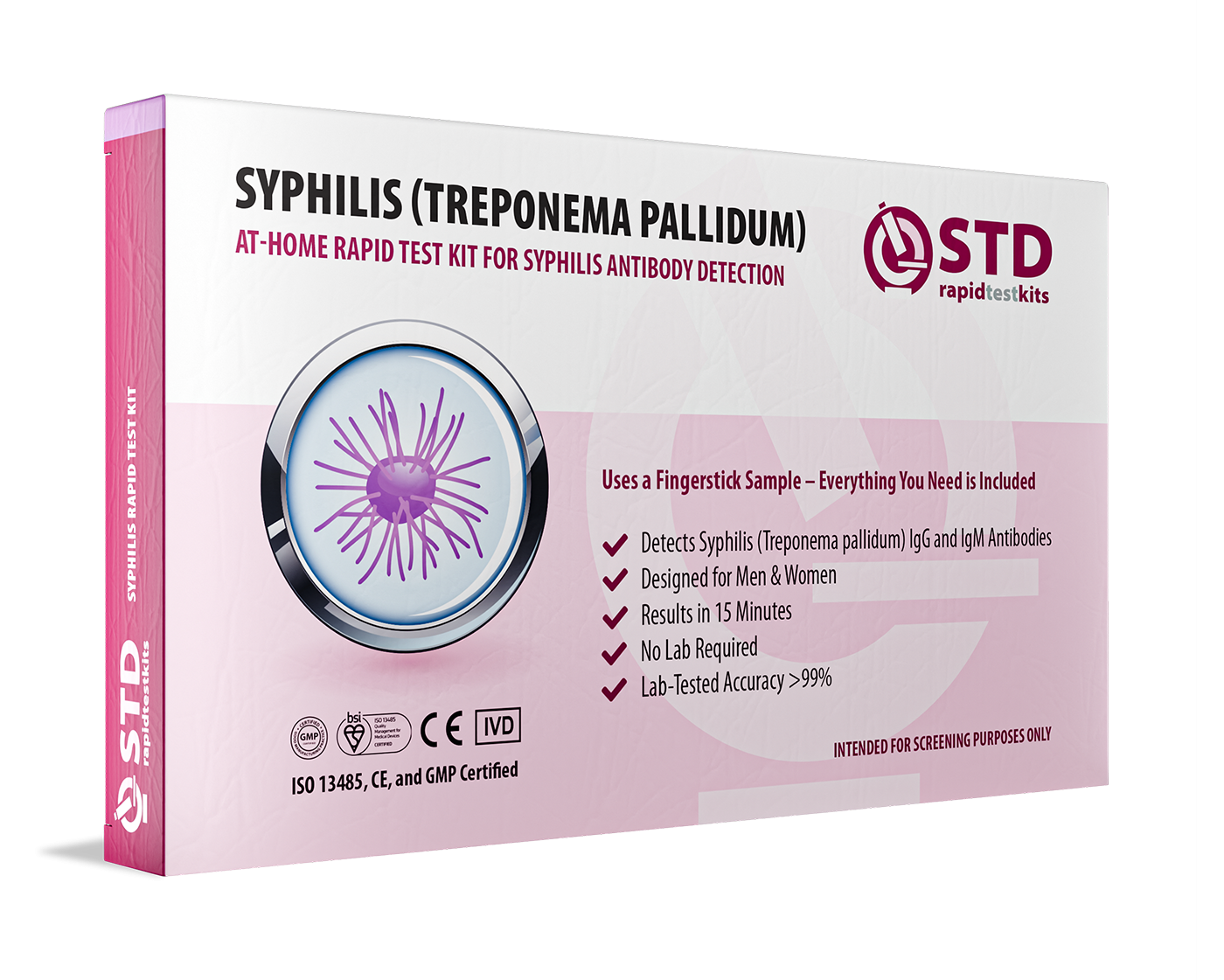Quick Answer: Syphilis is surging in Alabama, often showing up as painless sores or unexplained rashes. Most people miss the early signs, especially when they appear on the mouth or genitals. Home testing offers a fast, discreet way to protect yourself and others without the shame or clinic wait.
When the First Symptom Doesn’t Hurt, Most People Don’t Panic
The most common sign of primary syphilis is a single sore, called a chancre. It’s firm, round, and painless. That’s the problem. We expect infections to burn, itch, or swell. We don’t expect a soft, silent mark that goes away on its own. Many chancres appear on the vulva, penis, anus, or mouth, anywhere exposed during oral, anal, or vaginal sex. In some cases, especially among those with facial hair or darker skin tones, it’s mistaken for a pimple or follicle bump. No redness. No blister. No reason to worry… until it’s already spread.
In Alabama, where rural health access is strained and STD clinics are closing, missed symptoms are just the start. According to the CDC’s latest surveillance report, the U.S. has seen a 781% increase in congenital syphilis since 2012. Alabama’s own data reflects this spike, with cases of babies born with syphilis jumping from four in 2012 to over forty in 2022. That’s a tenfold increase, and every one of those outcomes was preventable, if their parent had been tested in time.
But “in time” means catching it during that first, painless window. And that window can be as short as three weeks. After that, the infection goes systemic, even if your skin looks clear.

People are also reading: How Regular HPV Testing Can Prevent Cervical Cancer
Case Study: “I Got It from a Guy I Met Twice”
DeAndre, 31, had been tested before. He knew the routine. Condoms most of the time, oral usually without. When he noticed a reddish patch just below his shaft, he assumed it was friction or lube irritation. “It wasn’t raised. It didn’t sting. I didn’t even Google it. It didn’t feel like anything,” he said. Two months later, he developed a rough rash on his palms. That’s when a walk-in clinic finally diagnosed him with secondary syphilis.
“I felt stupid. I’d been tested for everything… except that. Because no one talks about syphilis anymore. I didn’t even know what it looked like.”
He used an at-home syphilis test kit to monitor his treatment success. “Once I found out I could do it privately, I felt like I had power again,” he said. DeAndre is now STI-negative, but says the emotional shame of the diagnosis lingered longer than the rash.
This Didn’t Come Out of Nowhere, But We Act Like It Did
Let’s be honest: syphilis never left Alabama. It just got quieter. After decades of silence, the recent rise isn’t a shock to public health workers on the ground. It’s a symptom of years, decades, of underfunded clinics, abstinence-only sex ed, and medical distrust born out of generational trauma.
In 2023, Alabama ranked among the top five U.S. states for primary and secondary syphilis rates, with some counties seeing rates over 30 cases per 100,000. That’s not just a statistic. It’s someone’s sister. Someone’s son. Someone’s baby born with a preventable infection.
Part of this crisis stems from what Alabama still carries, namely, the historical weight of the Tuskegee Syphilis Study, conducted just a few hours from Montgomery. From 1932 to 1972, Black men were denied treatment for syphilis in the name of “research.” They weren’t told they were infected. They were lied to. And that betrayal didn’t end with an apology. It continues today in the form of deep distrust, generational silence, and people avoiding care until it’s too late.
It also shows up in who has access to safe testing. In Alabama’s rural counties, more than 25% of residents live without a primary care provider. Clinics are sparse. Transportation is an obstacle. And walking into a waiting room in a small town where your aunt is the receptionist? For many, that’s enough to avoid testing altogether.
Check Your STD Status in Minutes
Test at Home with RemediumSyphilis Test Kit

 For Men & Women
For Men & Women Results in Minutes
Results in Minutes No Lab Needed
No Lab Needed Private & Discreet
Private & DiscreetOrder Now $33.99 $49.00
Myths Are Killing Us, Literally
Let’s clear some things up. You can have syphilis and not know it. You can catch it from oral sex. It can pass to a baby even if you had no sores. A syphilis rash doesn’t always itch. You don’t need to be “promiscuous.” And yes, people still die from it if it goes untreated long enough. Neurosyphilis and cardiovascular damage are rare, but real.
In one 2021 study published in JAMA, researchers found that early syphilis continues to go undiagnosed even when people present with textbook symptoms, because many providers no longer consider it likely. In other words, even your doctor might miss it.
And if you’re a woman? Your symptoms are even more likely to be misread or dismissed as yeast, irritation, or hormonal skin changes. That’s how congenital syphilis happens, because someone got told, “It’s probably nothing.”
Why This Is Worse for Some of Us
This isn’t a virus that treats everyone equally. The burden falls heavier on those already marginalized: Black communities, queer and trans folks, people who don’t have insurance, and anyone in a zip code without a Planned Parenthood. In Alabama, congenital syphilis has been rising at a faster rate than in most of the country, with some counties reporting more newborn infections than HIV cases.
The solution isn’t just “use condoms” or “go get tested.” That advice ignores what it feels like to be terrified of judgment, to not have the gas money, or to carry the weight of cultural silence around anything sexual. It doesn’t work for people who’ve been shamed, ignored, or taught that STDs are punishment instead of medical issues.
But here’s the thing, this is medical. Syphilis is a bacteria, not a moral failing. And knowing your status isn’t something to be ashamed of. It’s something to be proud of.
Home Testing Isn’t Just Convenient, It’s Revolutionary
Picture this: you’re sitting on your bed. Hoodie on, phone in hand. You’ve Googled “syphilis sore or pimple” for the fourth night in a row. You don’t want to go to the health department because your cousin works there. You don’t want to go to your primary doctor because… you just don’t want to say the words. So you don’t.
This is where home testing changes everything. A discreet package. No clinic. No clipboard. No awkward eye contact. Just you, a quick finger prick, and answers in days. At-home syphilis test kits like the one from STD Rapid Test Kits are designed for this exact moment, the one where silence feels safer than exposure. But silence doesn’t protect you. Truth does.
Testing at home doesn’t mean testing alone. When you use a trusted test, you’re also connected to real next steps: treatment, follow-up, support. And if it’s positive? You’re not doomed. You’re not disgusting. You’re just one shot of penicillin away from being okay. That’s it. The CDC still recommends a single intramuscular injection of penicillin G benzathine for uncomplicated primary syphilis. For most people, that’s all it takes.
You can go from “I might have this” to “I’m clear” in one week. That’s not a death sentence. That’s a second chance.

People are also reading: STDs in Lesbian and Bisexual Women: Myths, Risks, and the Importance of Testing
Sex-Positive Doesn’t Mean Risk-Ignorant
Let’s be clear: talking about syphilis isn’t anti-sex. It’s pro-health. It’s pro-agency. It’s about respecting your body and your partners enough to know what’s going on down there. Whether you’re monogamous, exploring, celibate, kinky, vanilla, queer, straight, trans, or somewhere in between, you deserve accurate, judgment-free care. And that starts with knowledge.
Syphilis doesn’t care who you sleep with. But access to prevention, testing, and treatment? That’s where discrimination lives. The good news is that testing has never been more available. The bad news is that many people still think they’re not “the type” to need it.
If you’ve had unprotected sex, even once, you’re the type. If you’ve had oral sex without a barrier, you’re the type. If you’ve got a sore, a rash, or even just a gut feeling? You’re the type. Not because you’re dirty. But because you’re human.
Sex is not the problem. Silence is.
FAQs
1. What does a sore from syphilis look like?
A chancre, or syphilis sore, is usually round, hard, and doesn't hurt. It can show up on the genitals, mouth, or anus, and it usually goes away in a few weeks without leaving a scar, so it's easy to miss.
2. Is it possible to get syphilis from oral sex?
Yes. If you have a sore in your mouth or on your genitals, even if it's not visible or painful, you can get syphilis through oral sex.
3. How long does it take for the symptoms of syphilis to show up?
The first signs of syphilis usually show up between 10 and 90 days after being infected, with three weeks being the average. Secondary symptoms may not show up for weeks.
4. Is syphilis still common in the U.S.?
Yes. There have been a lot more cases of syphilis in the last ten years, with more than 200,000 reported in 2023. Alabama is currently one of the top five states for primary syphilis rates.
5. Is it possible to test for syphilis at home?
Of course. You can buy a reliable at-home syphilis test kit that comes with easy-to-follow instructions and private shipping. It's quick, private, and correct in terms of medicine.
6. What if my test for syphilis comes back positive?
Antibiotics, usually one shot of penicillin, work very well to treat syphilis. It's important to let your partners know and get more tests if necessary.
7. Is it dangerous to not treat syphilis?
Yes. If you don't treat syphilis, it can get worse and cause serious problems like damage to the brain and heart. It can also be passed on to unborn babies during pregnancy.
8. Why is the number of syphilis cases going up in Alabama?
Some of the reasons are less access to clinics, fear of being tested, and a long history of not trusting healthcare. Rural areas and communities that don't get enough services are hit the hardest.
9. Can the signs of syphilis be confused with something else?
Yes, most of the time. Chancres don't hurt and can be mistaken for ingrown hairs, razor burn, or irritation. Rashes can look like allergies or dry skin.
10. How often do I need to get tested?
Get tested every three to six months if you have sex, especially with new or multiple partners. Test right away if you notice any symptoms.
Know Your Status. Keep Your Power.
Syphilis didn’t disappear. It just got better at hiding. But you don’t have to stay in the dark. Whether it’s a sore, a weird rash, or just a gut feeling, listen to your body. Trust your instincts. And don’t let shame write your story.
Getting tested doesn’t mean you’ve done something wrong. It means you’re paying attention. You’re protecting yourself. You’re protecting your partners. You’re refusing to let an outdated STD steal your health or your peace.
Don’t wait and wonder, get the clarity you deserve.
Sources
1. Alabama Reflector: Soaring Congenital Syphilis Rates
2. Alabama Reflector: 10-Year Congenital Syphilis Spike
3. Alabama Public Health: Syphilis Prevention










